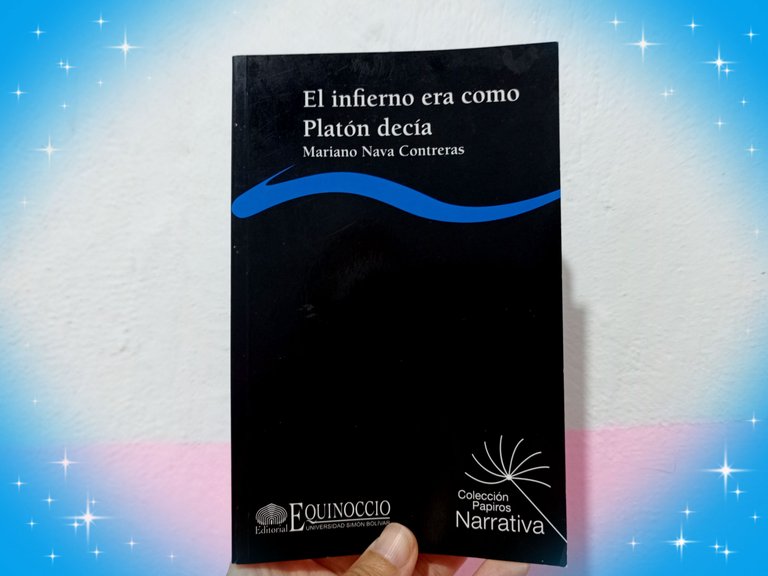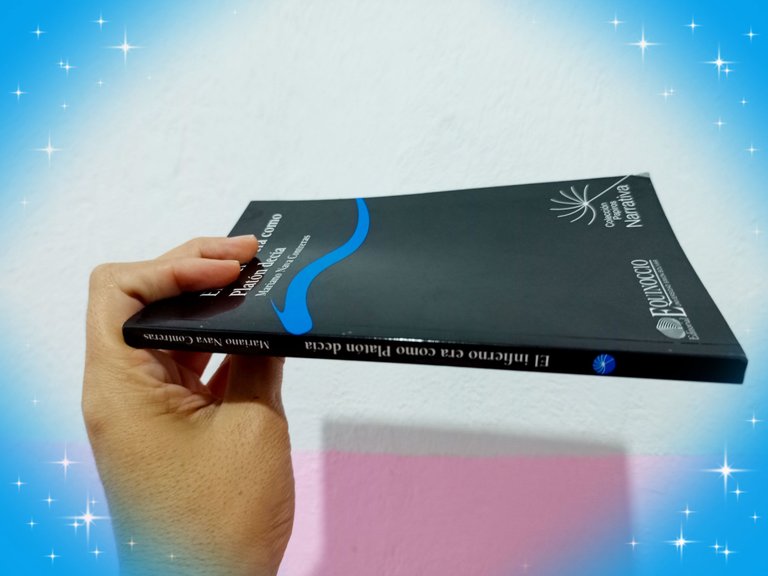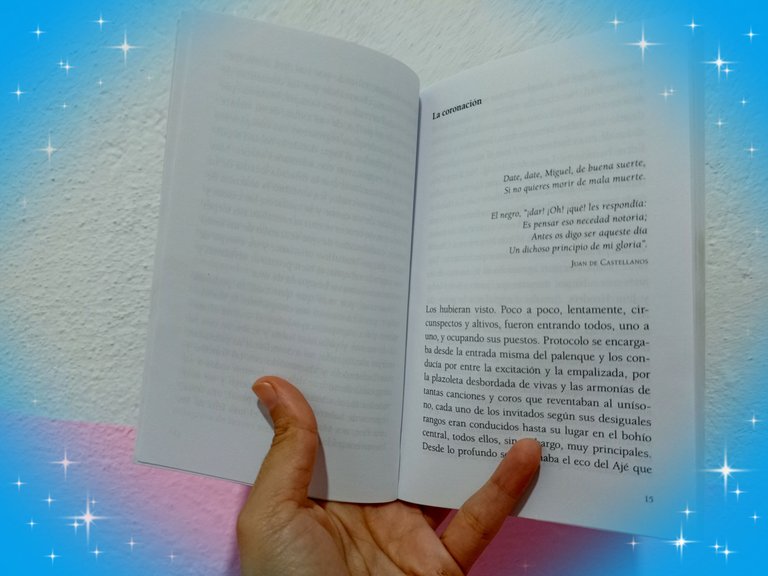Today I decided to delve into the narrative of Mariano Nava Contreras, specifically in his book of short stories Hell was as Platon said. This Venezuelan author is characterized by using a multiplicity of universal references to support his stories, for this reason, his writing looks designed for his ideal reader, whose knowledge of the world is broad and, therefore, is able to decipher in its fullness all the author's approaches. Nava Contreras' work is not static, his proposals have been aiming higher over time and although I admit that it took me a while to approach these stories, with the help of the internet I was able to realize several references that I did not know, so I acquired more knowledge.
From the selection I chose three stories that seemed significant to me, the first one is entitled Martín Tinajero, here description is privileged over narration, which represents a challenge in terms of writing. The narrator creates a very singular atmosphere, giving the focus to a feminized bee that presents the production of honey from the fluids of a corpse. Although this approach seems somewhat illogical, it works as an excuse to create sensations for the reader from fiction.

The narrator uses the right words to provoke very suggestive sensory images, but then, after confirmation that the body belongs to Martín Tinajero, he begins the process of decomposition, which is described in a grotesque scene. The exploration of an element that could be considered macabre is seasoned with poetic language. The story, from my perspective, invites us to reflect on life and death, a theme that is reiterative in the author's work.
The second story is entitled The coronation, here the narrator immerses us in the heart of the Afro culture or black community, highlighting their customs and traditions through popular references. In this story we witness the ceremony of someone who proclaims himself the monarch of blackness in the midst of an act with deep racial and spiritual significance. At this point, identity plays a very important role because the narrator uses beliefs, urban areas, music, cultors, sports icons and even historical characters to exalt the race of his ancestors.

In this story the narrator presents an inventory of elements and references that are typical of a culture, also expressed through a language that uses expressions typical of the Latin suburbs. Here there is a voice that wants to be heard, a voice that wants to preserve its identity in the face of discrimination and marginalization in a globalized world.
The third story that caught my attention is called Hell was as Platon said, which gives the book its name. It is definitely an attention-grabbing title and an invitation to read. Here the narrator offers us a mix between Greek philosophy and the mythology of the Wayúu Indians to present us with a fascinating story.

This story explores the transition between life and death and spiritual transformation, something that has been the subject of philosophical study since time immemorial. The story introduces us to a protagonist who is able to move from one dimension to another, it begins in classical Greece, there he suffers for the loss of his wife, a blind pain that leads him to think of his own death, but the intense light at the end of the road is the border that divides time, so when he crosses the threshold he is transformed into an Indian who also suffers for a love.
This story does not have a simple approach, the main character goes from one dimension to another, from the Greek to the indigenous, a journey that could be intrinsic, where knowledge of the external world is elementary, thus proposing an exploration of parallel realities and the perception of the unknown. Again the wealth of historical and cultural references fall upon the reader to convince him of the possibility of what is being proposed.

Hoy decidí adentrarme en la narrativa de Mariano Nava Contreras, específicamente en su libro de cuentos El infierno era como Platón decía. Este autor venezolano se caracteriza por valerse de una multiplicidad de referentes universales para sustentar sus relatos, por tal razón, su escritura luce pensada para su lector ideal, cuyo conocimiento del mundo sea amplio y, por lo tanto, sea capaz de descifrar en su plenitud todos los planteamientos del autor. La obra de Nava Contreras no es estática, sus propuestas han ido apuntando más alto a través del tiempo y aunque admito que me costó un poco aproximarme a estos relatos, con la ayuda de internet pude dar cuenta de varios referentes que desconocía, así que adquirí más conocimientos.
De la selección elegí tres cuentos que me parecieron significativos, el primero se titula Martín Tinajero, aquí la descripción se privilegia por sobre la narración, lo que a nivel de escritura representa un reto. El narrador crea una atmósfera muy singular, otorgando la focalización a una abeja feminizada que presenta la producción de miel a partir de los fluidos de un cadáver. Si bien este planteamiento luce un tanto ilógico, funciona como excusa para crear sensaciones al lector desde la ficción.

El narrador emplea las palabras adecuadas para provocar imágenes sensoriales muy sugerentes, pero luego, tras la confirmación de que el cuerpo pertenece a Martín Tinajero, inicia el proceso de descomposición, que es descrito en una escena grotesca. La exploración de un elemento que podría considerarse macabro es aderezado con lenguaje poético. El relato, desde mi perspectiva, invita a reflexionar sobre la vida y la muerte, un tema que es reiterativo en la obra del autor.
El segundo cuento se titula La coronación, acá el narrador nos sumerge en el corazón de la cultura afro o comunidad negra, resaltando sus costumbres y tradiciones a través de referentes populares. En este relato asistimos a la ceremonia de alguien que se proclama el monarca de la negritud en medio de un acto con profundo significado racial y espiritual. En este punto, la identidad juega un papel bastante marcado porque el narrador utiliza creencias, zonas urbanas, música, cultores, íconos deportivos y hasta personajes históricos, para enaltecer la raza de sus ancestros.

En este cuento el narrador presenta un inventario de elementos y referencias que son propios de una cultura, también se expresa mediante un lenguaje que utiliza expresiones propias de los suburbios latinos. Acá hay una voz que desea ser escuchada, esa que vela por preservar su identidad frente a la discriminación y la marginalidad en un mundo globalizado.
Por su parte, el tercer cuento que captó mi atención lleva por nombre El infierno era como Platón decía, el cual da nombre al libro. Definitivamente es un título que llama la atención y es una invitación a la lectura. Aquí el narrador nos ofrece una mezcla entre la filosofía griega y la mitología de los indios Wayúu para presentarnos una historia fascinante.

Este cuento explora la transición entre la vida y la muerte y la transformación espiritual, algo que ha sido objeto de estudio de la filosofía desde tiempos inmemoriales. La historia nos presenta a un protagonista que es capaz de trasladarse de una dimensión a otra, inicia en la Grecia clásica, allí sufre por la pérdida de su esposa, un dolor ciego que le lleva a pensar en su propia muerte, pero la luz intensa al final del camino es la frontera que divide el tiempo, así que al traspasar el umbral se transforma en un indio que también sufre por un amor.
Este relato no posee un planteamiento sencillo, el personaje principal va de una dimensión a otra, de lo griego a lo indígena, un viaje que podría ser intrínseco, donde el conocimiento del mundo externo es elemental, se propone así una exploración de realidades paralelas y la percepción de lo desconocido. De nuevo el caudal de referencias históricas y culturales caen sobre el lector para convencerlo de la posibilidad de lo que se está planteando.

✓Photos from my personal gallery, edited with Fotocollage.
✓Text translated with DeepL.
📘💗📘💗📘💗📘💗
✓Fotos de mi galería personal, editadas con Fotocollage.
✓Texto traducido con DeepL.